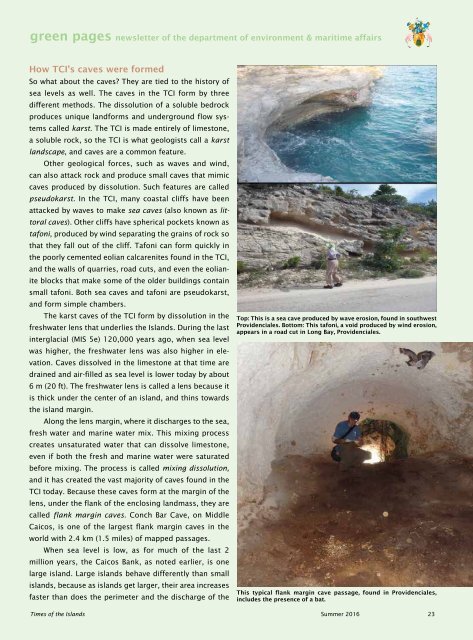Times of the Islands Summer 2016
Presents the "soul of the Turks & Caicos Islands" with in-depth features about local people, culture, history, environment, businesses, resorts, restaurants and activities.
Presents the "soul of the Turks & Caicos Islands" with in-depth features about local people, culture, history, environment, businesses, resorts, restaurants and activities.
Create successful ePaper yourself
Turn your PDF publications into a flip-book with our unique Google optimized e-Paper software.
green pages newsletter <strong>of</strong> <strong>the</strong> department <strong>of</strong> environment & maritime affairs<br />
How TCI’s caves were formed<br />
So what about <strong>the</strong> caves? They are tied to <strong>the</strong> history <strong>of</strong><br />
sea levels as well. The caves in <strong>the</strong> TCI form by three<br />
different methods. The dissolution <strong>of</strong> a soluble bedrock<br />
produces unique landforms and underground flow systems<br />
called karst. The TCI is made entirely <strong>of</strong> limestone,<br />
a soluble rock, so <strong>the</strong> TCI is what geologists call a karst<br />
landscape, and caves are a common feature.<br />
O<strong>the</strong>r geological forces, such as waves and wind,<br />
can also attack rock and produce small caves that mimic<br />
caves produced by dissolution. Such features are called<br />
pseudokarst. In <strong>the</strong> TCI, many coastal cliffs have been<br />
attacked by waves to make sea caves (also known as littoral<br />
caves). O<strong>the</strong>r cliffs have spherical pockets known as<br />
tafoni, produced by wind separating <strong>the</strong> grains <strong>of</strong> rock so<br />
that <strong>the</strong>y fall out <strong>of</strong> <strong>the</strong> cliff. Tafoni can form quickly in<br />
<strong>the</strong> poorly cemented eolian calcarenites found in <strong>the</strong> TCI,<br />
and <strong>the</strong> walls <strong>of</strong> quarries, road cuts, and even <strong>the</strong> eolianite<br />
blocks that make some <strong>of</strong> <strong>the</strong> older buildings contain<br />
small tafoni. Both sea caves and tafoni are pseudokarst,<br />
and form simple chambers.<br />
The karst caves <strong>of</strong> <strong>the</strong> TCI form by dissolution in <strong>the</strong><br />
freshwater lens that underlies <strong>the</strong> <strong>Islands</strong>. During <strong>the</strong> last<br />
interglacial (MIS 5e) 120,000 years ago, when sea level<br />
was higher, <strong>the</strong> freshwater lens was also higher in elevation.<br />
Caves dissolved in <strong>the</strong> limestone at that time are<br />
drained and air-filled as sea level is lower today by about<br />
6 m (20 ft). The freshwater lens is called a lens because it<br />
is thick under <strong>the</strong> center <strong>of</strong> an island, and thins towards<br />
<strong>the</strong> island margin.<br />
Along <strong>the</strong> lens margin, where it discharges to <strong>the</strong> sea,<br />
fresh water and marine water mix. This mixing process<br />
creates unsaturated water that can dissolve limestone,<br />
even if both <strong>the</strong> fresh and marine water were saturated<br />
before mixing. The process is called mixing dissolution,<br />
and it has created <strong>the</strong> vast majority <strong>of</strong> caves found in <strong>the</strong><br />
TCI today. Because <strong>the</strong>se caves form at <strong>the</strong> margin <strong>of</strong> <strong>the</strong><br />
lens, under <strong>the</strong> flank <strong>of</strong> <strong>the</strong> enclosing landmass, <strong>the</strong>y are<br />
called flank margin caves. Conch Bar Cave, on Middle<br />
Caicos, is one <strong>of</strong> <strong>the</strong> largest flank margin caves in <strong>the</strong><br />
world with 2.4 km (1.5 miles) <strong>of</strong> mapped passages.<br />
When sea level is low, as for much <strong>of</strong> <strong>the</strong> last 2<br />
million years, <strong>the</strong> Caicos Bank, as noted earlier, is one<br />
large island. Large islands behave differently than small<br />
islands, because as islands get larger, <strong>the</strong>ir area increases<br />
faster than does <strong>the</strong> perimeter and <strong>the</strong> discharge <strong>of</strong> <strong>the</strong><br />
Top: This is a sea cave produced by wave erosion, found in southwest<br />
Providenciales. Bottom: This tafoni, a void produced by wind erosion,<br />
appears in a road cut in Long Bay, Providenciales.<br />
This typical flank margin cave passage, found in Providenciales,<br />
includes <strong>the</strong> presence <strong>of</strong> a bat.<br />
<strong>Times</strong> <strong>of</strong> <strong>the</strong> <strong>Islands</strong> <strong>Summer</strong> <strong>2016</strong> 23

















